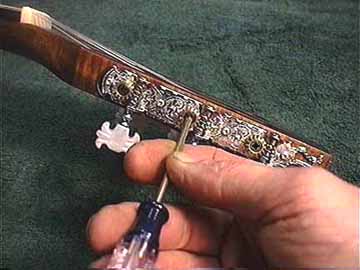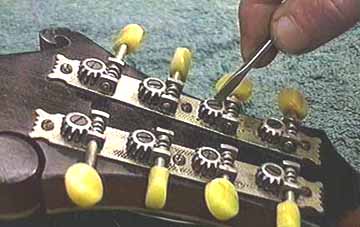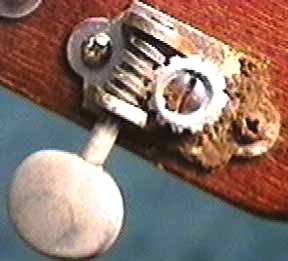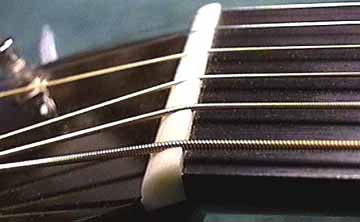Page 3 of 3
Back to the open tuners. Open tuners have their gears held on by a screw. When this
screw works loose, the gear can fall off. This is not good. Another very common misconception
is that you should tighten the hell out of these screws to make the tuners hold better.
It doesn't work that way. The screw just holds the gear on and keeps it from falling
off. On some tuners, it's very easy to tighten the screw and unintentionally clamp
the gear against the plate, making the whole thing work very poorly indeed.
Here's another quickie rule of thumb. If the gear is held on by a Phillips screw,
the tuners are more likely to be Asian or European, and less likely to be impaired
by over-tightening the screw:

These are Asian gears, and you can tighten the screw without pinching the plate.
A good way to check it the screw binds the gear to the plate is to tighten it sometime
when you've taken the string off and see if you can wiggle the gear back and forth.
If you can move the gear easily with your fingers, then you've got no problem.
The tiny wood screws that fasten the gear plates are easily stripped
out by over tightening. Individual gears usually have these tiny little screws, too.
These screws should be tight enough to hold the gears in place. If yours are stripped,
check out Fixing
Stripped Wood Screws. It's easy, and anyone with a
screwdriver can fix a stripped wood screw!
American gears, especially older ones, are much more likely to need sensitive treatment.
These tuners are on a Gibson mandolin made about 1920:

I have to be very careful to tighten these screws VERY gently to avoid pinching the
plate between the string post and the gear. The looser these screws are, the better
the gears work. I mean that literally.
What's wrong with over-tightening the screw? Well, it goes like this: If the gear
binds against the plate, then the string will not be able to pull the gear back against
the worm. Then when you tune up to a note, you're not only working harder, but the
tuner post will tend to stay bound in that position. Since the gear will not be exerting
any backward force against the worm, the worm is free to loosen. When the worm backs
off a little under normal vibration, it may begin to rattle. That's irritating! Even
if the worm doesn't rattle, it can vibrate backward a little. Then at an inopportune
moment the tuner post and gear can jerk back, taking up the slack. It's weird, but
by tightening and pinching the gear against the plate you can actually cause a tuner
to be less likely to hold the pitch.
When in doubt, oil them, don't soak them in salt
water:


I've included this close-up of a nut to illustrate a popular misconception. It's
really common for a string to "bind" in the nut. It could be pinched because
the nut slot was cut incorrectly. A string sitting in a nut made of material that
is too soft will actually make a negative impression of its windings. These little
ribs will cause the string to jump in tiny increments as it is tuned up.
A string that binds in the nut will cause a "ping" sound as it is tuned
to pitch. It may ping several times, or every time it's tuned. It may ping just once
in a while. It's very common for fragile strings, such as the octave G string on
a 12-string guitar, to break before they reach concert pitch. That's because the
string is binding in the nut and greater tension is required to tune it.
When you tune your guitar and it pings or breaks strings, it's natural to blame the
tuners, but it's more than likely the nut's fault.
It's a simple matter for a guitar technician to clean up the nut slots with special
little files, or to make
a new nut of bone (my favorite material.)
1
2
3
Back to Index Page